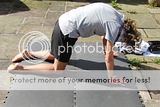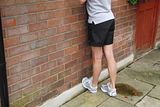Training & advice
Static stretching
Stretching is an important part of your running training as it can improve your range of movement and help to prevent injury so it is hard to understand why many runners neglect it. If you have a greater range of movement you will be able to cover more ground with each step and this means running your chosen distance wither fewer steps and a quicker time. It's a no-brainer really: running more freely, quickly, efficiently and less inclined to injury! There are two basic times to stretch and types of stretches to use. During a warm up runners should perform dynamic stretching and static stretching should be performed after training or as a seperate session on its own. Static stretching should be performed slowly without bouncing. The stretch should not hurt. If it does then you are pushing it too far. Likewise, if it feels very tight then you should back off. Click here for our guide on how types of stretching and how long to hold a stretch.
The time that you hold the stretch for will depend on whether you are stretching after training to realign the muscle fibres or whether the session is a pure flexibility session where you want to increase range of movement. If it is the former you should hold the stretch between 8 and 12 seconds and if it is the latter the stretch should be held for approximately 30 seconds, this way the muscle tension falls and the muscle can be stretched further.
Read on for our Top Ten stretches for runners. Please note that stretching should always be carried out on both sides so, for example, once you have held a stretch on the right leg for 10 seconds you should repeat it on the left leg for the same amount of time. It is important to be as symmetrical as you can be!
| Side of trunk | |
 |
1. Stand with feet a little over shoulder width apart 2. Keep back straight 3. Take arm over head 4. Feel stretch down side of trunk |
| Back | |
 |
1. Make a 'happy cat', 'angry cat' by sinking and arching the back 2. Push through your hands 3. Go from happy cat to angry cat and back four or five times holding it for 10 seconds at a time |
 |
|
| Ouside of thigh and hip - Iliotibial Band | |
 |
1. Cross one foot behind the other 2. Keep back straight 3. Push hip of back leg away from centre of body 4. Feel stretch on outer side of rear thigh and hip |
| Inside of thigh - adductors | |
 |
1. Stand with feet a little over shoulder width apart 2. Keep back straight 3. Feet face forward 4. Lean to one side, bending that knee |
| Groin stretch | |
 |
1.Sit on your bottom 2. Soles of feet together 3. Elbows inside knees 4. Gently push your legs towards the floor. |
| Front of thigh - quadraceps | |
 |
1.Knees level 2. Support leg slightly bent 3. Sand tall with tummy in 4. Feel stretch on front of thigh |
| Back of thigh - hamstrings | |
 |
1. One leg in front of the other, straight knee 2. Hands on bent knee 3. Sit back on support leg with bottom out and straight back 4. Feel stretch on back of thigh of straight leg |
| Back of thigh - hamstrings | |
 |
1. Hook a towel or similar over foot 2. Lie on back with leg in the air 3. Pull gently towards your body with the towel 4. Feel stretch on back of raised leg |
| Back of lower leg - calf - gastrocnemius | |
 |
1. Stand close to a wall 2. Position one foot with toes against the wall and heel on the ground 3. Lean in towards the wall with hips 4. 'Pull' the knee upwards 5. Feel stretch at the back of rear lower leg |
| Back of lower leg - calf - soleus | |
 |
1. Follow on from the gastrocnemius stretch 2. Bend the knee in towards the wall 3. Stretch felt in the lowest part of the calf |
